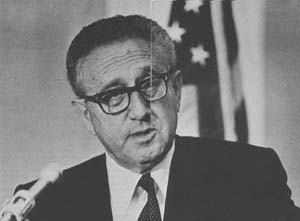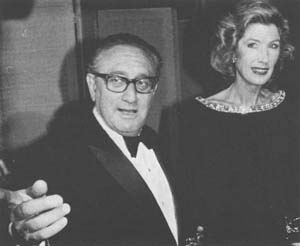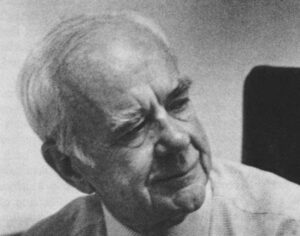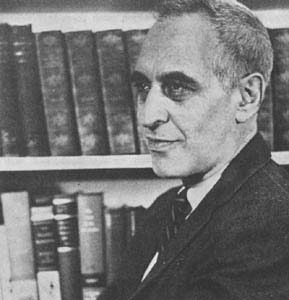Is Henry Kissinger a conservative? This is not merely a question of semantics but one that bears upon the nature of American conservatism and the current policy disputes bedeviling it.
Like all political categories, that of conservative was defined historically by a political movement. In the U.S. the present meaning of conservative came about as the result of a political struggle waged during the ’50s in journals and magazines, but decided finally by Barry Goldwater’s presidential nomination in 1964.
Kissinger was on the losing side of this battle, and his defeat is reflected in the enmity that many self-described conservatives feel towards him. But the losers in the ’50s, who included not just Kissinger, but a group of academics and intellectuals that styled themselves the “new conservatives,” may be making a comeback in the ’80s.

Throughout his career, Henry Kissinger has thought of himself as a conservative, but he distinguishes between his conservatism and that of most of the American right. Kissinger styles himself as an “historical” or a “Disraeli conservative” and rejects what he sees as “Manchester liberalism”–the philosophy of unrestricted laissez-faire capitalism.
In an interview in his Washington office last fall, Kissinger explained that he had always thought of himself as a conservative:
I have thought of myself as a Disraeli conservative. Most American conservatives are Manchester liberals, in my opinion, or populists. I don’t even consider them conservatives, although of course they are conservatives if they call themselves conservatives. It seems to me the essence of conservatism is to have change evolve from existing structures and to avoid sudden convulsive disruption. This means that evolution should be gradual, but also that one should not be unbending. Indeed the great domestic reforms in Europe in the nineteenth century were generally carried out by conservatives: universal suffrage by Disraeli and also by Bismarck. And in foreign policy, it was to develop a feel for the natural interests of states and to arrange an equilibrium, based on that.
Roger Morris, who served under Kissinger in the National Security Council in 1969-70, confirms that Kissinger thought of himself then as a “conservative,” but as different from the typical American conservative:
Conservatives were thought of as being conservative in a domestic political sense, not conservative in the same sense that Kissinger saw himself, which was Old World conservative and much more sophisticated about international affairs and politics and much more knowledgeable and worldly and cynical.
Kissinger developed his concept of historical conservatism at Harvard, where he was an undergraduate after the war, and then a graduate student in Government. His views reflected both his own European background and influences and the ideas of a group of academics and intellectuals that called themselves the “new conservatives.”
The new conservatives, who included poet Peter Viereck, McGeorge Bundy (then a professor in the government department), New York Herald Tribune editorialist August Heckscher, and Cornell political scientist Clinton Rossiter, identified with European conservatives like Burke, Disraeli, and Metternich. They regarded the right wing of the Republican party–virulent anti-New Deal and isolationist–as reactionary rather than conservative, and they cast their hopes with Republican or Democratic moderates.
As a graduate student, Kissinger edited a journal, Confluence, that published Bundy, Viereck, Heckscher, and other new conservatives. Confluence’s aim was to bring together European and American intellectuals to discuss broad political questions–the first issue was devoted to the question, “What are the Bases of Civilization?” In the words of Kissinger’s fellow graduate student Stephen Graubard, who became assistant editor in 1956, Confluence “belonged neither to the left nor the right.”
But Confluence’s indifference to partisan political disputes in the United States was itself a politics. Confluence was “beyond left or right” in the sense that, from Kissinger’s European perspective, what mattered was not whether one was a Republican or a Democrat, but whether, broadly defined, one was conservative or a revolutionary. The only groups outside this conservative consensus were the reactionary right and the revolutionary left. Thus, Black novelist and civil rights proponent Ralph Ellison, liberal Arthur Schlesinger, Bundy and Russell Kirk, the author of The Conservative Mind, could all write for Confluence.

Kissinger’s first book, A World Restored, which he wrote while a graduate student at Harvard in 1953-54, was a study of the peace agreement reached by European Powers after the Napoleonic Wars–an agreement that yielded one hundred years of relative stability. The categories and distinctions that he developed in that book reflected his historical conservatism and have served him throughout his career.
According to Kissinger, there were two kinds of international systems: a “legitimate order” based upon a balance of power and the recognition of competing national interests, and a “revolutionary order” sustained by force. Revolutionary powers like Napoleon’s France or Hitler’s Germany, whose goal was to overturn the existing order, precipitated revolutionary situations–and total war. Wars could still occur within legitimate world orders, but they would “be fought in the name of the existing structure and the peace which follows will be justified as a better expression of legitimate, general consensus.”
From 1813 to 1815, the period that Kissinger surveyed most closely, the goal of Metternich in Austria and Castlereagh in Britain was to transform Napoleon’s “revolutionary order” into a “legitimate one.” According to Kissinger, they succeeded at the Congress of Vienna because they understood that while a legitimate order precluded the existence of revolutionary powers, it did not rule out conflict and change. He wrote:
The issue at Vienna…was not reform against reaction…The problem was to create an order in which change could be brought about through a sense of obligation, instead of through an assertion of power. For the difference between a revolutionary order and a healthy legitimate order is not the possibility of change but the mode of its accomplishment.
Kissinger’s model was not Metternich but the concord that he and Castlereagh wrought. Kissinger admired Metternich as a diplomat–Metternich alone had understood that the goal of policy was not the defeat of Napoleon, but the creation of a stable order. But Kissinger saw him limited by his inability to affect the decaying Hapsburg monarchy whose interests he had to represent. “He understood the forces at work better than most of his contemporaries,” Kissinger wrote of Metternich, “but this knowledge proved of little avail, because he used it almost exclusively to deflect their inexorable march, instead of placing it into his serve for a task of construction.”
As he would later insist to students of his policy, he was more inclined to model himself after Disraeli and Bismarck–men who shaped their nation’s domestic as well as international politics–than after Metternich.
In his best-selling Nuclear Weapons and Foreign Policy, written in 1955 under the auspices of the Council on Foreign Relations, Kissinger applied the lessons of A World Restored to the Cold War. Kissinger would later repudiate some of the proposals in this book, such as his support for waging limited nuclear war. But together with A World Restored, it provided the underlying structure of his foreign policy.
According to Kissinger, the U.S., like Austria, found itself to be a “status quo power” seeking stability, while a revolutionary power, the Soviet Union, sought to overturn the legitimate order of nations. Its strategy, like Austria’s, had to be to force the Soviet–through guile and threats and war, if necessary–to abandon its revolutionary goals and join the U.S. in a new concert of nations. But the task of doing so was complicated by the introduction of nuclear weapons.
Nuclear weapons not only threatened the extinction of both sides. According to Kissinger, their existence inhibited American strategists from contemplating war as an instrument of policy. Instead, American policy-makers had limited the use of nuclear weapons–and war itself–to “massive retaliation” in case of a Soviet surprise attack.
The result was a policy disaster. By ruling out war and the threat of war, the U.S. allowed the Soviet Union to score political and military gains–even when the U.S. enjoyed a virtual monopoly of nuclear weapons. “The enormity of modern weapons makes the thought of war repugnant,” Kissinger wrote, “but the refusal to run any risks would amount to giving the Soviet leaders a blank check.”
Kissinger restated the problem in terms of the goal of policy. By making peace itself–the absence of war–its paramount concern, the U.S. had put itself “at the mercy of the state willing to forego peace…Peace cannot be aimed at directly; it is the expression of certain conditions and power relationships. It is to these relationships–not peace as such–that diplomacy must address itself.”
Kissinger argued for an aggressive diplomacy aimed not at merely containing Soviet expansion, but at exploiting Soviet weaknesses. According to Kissinger, the willingness to undertake limited wars–if necessary, with nuclear weapons–was essential to doing so.
Kissinger did not rule out negotiations with the Soviet Union–he thought in particular that negotiations could be directed at preventing a surprise attack and an unlimited nuclear war–but he warned against accepting Soviet protestations of “peaceful coexistence.”
Over the long run, the goal of American policy should be to convert the Soviet Union from a revolutionary into a “status quo power.” But that would only occur when “a revolutionary movement…came to be opposed with equal fervor or when it reached the limit of its military strength.”
After the publication of Nuclear Weapons and Foreign Policy, Kissinger became an advisor to Nelson Rockefeller. In 1964, before the tumultuous Republican convention in San Francisco, where Rockefeller led the anti-Goldwater forces, he became Rockefeller’s chief foreign policy advisor. In accordance with his own view of conservatives, Kissinger saw Rockefeller as an “instinctive conservative.”
Such an association with Rockefeller was sufficient in itself to discredit Kissinger among many American conservatives, but there were also important political differences between Kissinger’s conservatism and that of the Goldwater conservatives.
The conservative movement that emerged in the late ’50s was marked by the early Republican right. It was reactionary rather than conservative with respect to the New Deal and the welfare state–even Goldwater had favored making social security voluntary. And while it was profoundly anti-Communist, it had little enthusiasm for the postwar strategy of international alliance that Kissinger and the new conservatives favored. Many of these conservatives favored a preemptive strike against the Soviet Union. And they favored a quick kill rather than a protracted intervention in Vietnam.
Even the more internationalist and sophisticated postwar conservatives parted company with Kissinger. Unlike James Burnham, Whittaker Chambers and the other former leftists who helped formulate conservative foreign policy, Kissinger never was convinced that the Soviet Union was more powerful militarily or economically than the U.S. His entire strategy rested on the assumption that the Soviet Union was vulnerable to pressure and could not risk a face-to-face confrontation.
Kissinger believed that a long-term strategy of pressure that combined force, threats of force, and negotiation could succeed; where much of the American right believed either that the issue had already been decided or that only a final and imminent confrontation with Soviet power–”while there was still time”–could succeed in downing the Soviet behemoth.
The American right was committed to the destruction of the Soviet Union, while Kissinger, like Metternich, sought only a stable world order. Kissinger did not seek to alter the Soviet Union’s domestic policy, except in so far as it affected its foreign policy. The conservatives could not make such a distinction: to them, communism was indivisible force incapable of alteration. (Even conservatives like Burnham found the Sino-Soviet split inconceivable, while Kissinger was speculating how it could be brought about in Nuclear Weapons and Foreign Policy.)
To Kissinger, the conservatives were like Czar Alexander who sought in 1815 to achieve peace through submission to his own religious ideals. “Castlereagh and Metternich,” Kissinger wrote, “sought a world of intermediary nuance; Alexander one of immediate perfection.”
Kissinger summed up his own differences with the right. “My objection to American conservatives is they confuse foreign policy with theology, that they seem more interested in the affirmation of abstract principles than in implementing partial steps toward realizing these principles.”
But some conservatives, like political scientist Warren Nutter, argue that while the principles espoused in Kissinger’s earlier books represented a legitimate conservative strategy, he betrayed those principles when he served as National Security Advisor and Secretary of State. Kissinger himself has spent the last decade arguing that he did not, but on this score the conservatives may have a point.
Kissinger and Nixon embarked upon a policy of détente in the hope that they could stem the disintegration of the Western alliance and win Soviet acquiescence in American objectives in Southeast Asia and elsewhere. They sought to resist the spread of revolution by acknowledging its permanence in the Soviet Union and Eastern Europe. They got part of what they wanted–Soviet and Chinese pressure on North Vietnam to settle and Soviet cooperation in the Mideast. They also succeeded in ridding Chile of a pro-Soviet government. So in this sense détente was at worst a tactical retreat within an overall anti-revolutionary strategy.
But at times both Nixon and Kissinger suggested that détente was not merely a tactic in the Cold War, but rather its replacement by a new era of cooperation: détente as the Congress of Vienna. In the President’s 1972 State of the World address, for which Kissinger was responsible, Nixon stated that “our alliances are no longer addressed primarily to the containment of the Soviet Union and China behind an American shield. They are instead addressed to the creation with those powers of a stable world peace.”
Even in the latter case, however, Kissinger can only be accused by conservatives of misapplying his own principles rather than abandoning them. Kissinger always assumed that at some point the Soviet Union could be brought into a stable world order–he may have erred by believing that this objective could be accomplished in 1972.
As far as conservatives were concerned, Kissinger’s sins in office more clearly followed not from his exaggeration of détente’s accomplishments, but from his rigorous application of the principles of A World Restored. It was from these principles that Kissinger’s indifference as a diplomatic to communism’s internal policies–whether in the Soviet Union or China–stemmed. And it was from these principles that the ultimate objective of détente–the creation of stability rather than the elimination of communism–stemmed.
In the 1976 Republican primaries, Reagan made Kissinger the goat for Gerald Ford’s foreign policies, but in 1980, to the consternation of “new right” conservatives, Reagan welcomed Kissinger as an advisor to his campaign. He appointed Kissinger’s protégé Alexander Haig as Secretary of State and conspicuously sought Kissinger’s advice–appointing him in 1983 the head of a Commission on Central America.
Some prominent older conservatives like William F. Buckley, Jr. had defended Kissinger, but now even the militant Human Events praised the report of Kissinger’s Commission on Central America.
Kissinger’s rehabilitation represents, in effect, the rehabilitation of Kissinger’s historical conservatism. On the one hand, the split between the new conservatives and the Goldwater conservatives represented the split between a European-oriented, academic conservatism and a more native American variety. But it also represented the split between a conservatism that was unsuitable for governing and one whose main use was polemical and rhetorical.
Intransigent opposition to the welfare state and to any negotiations with the Soviet Union had their place in fomenting a rebellion against reigning liberal Democratic politicians, but as the Reagan administration was to discover in office, they do not yield a set of policies to guide America through the craggy shoals of Congress or world diplomacy.
The Reagan administration has by no means become converted to the “new conservatism” or to A World Restored, but in its response to a succession of domestic and foreign imbroglios, from social security reform to Polish debt and nuclear arms control, the principles espoused by Kissinger in the ’50s can be heard echoing in the corridors.
©1986 John B. Judis
John B. Judis, senior editor on leave from In These Times, concludes his study of the development of American conservative politics.



